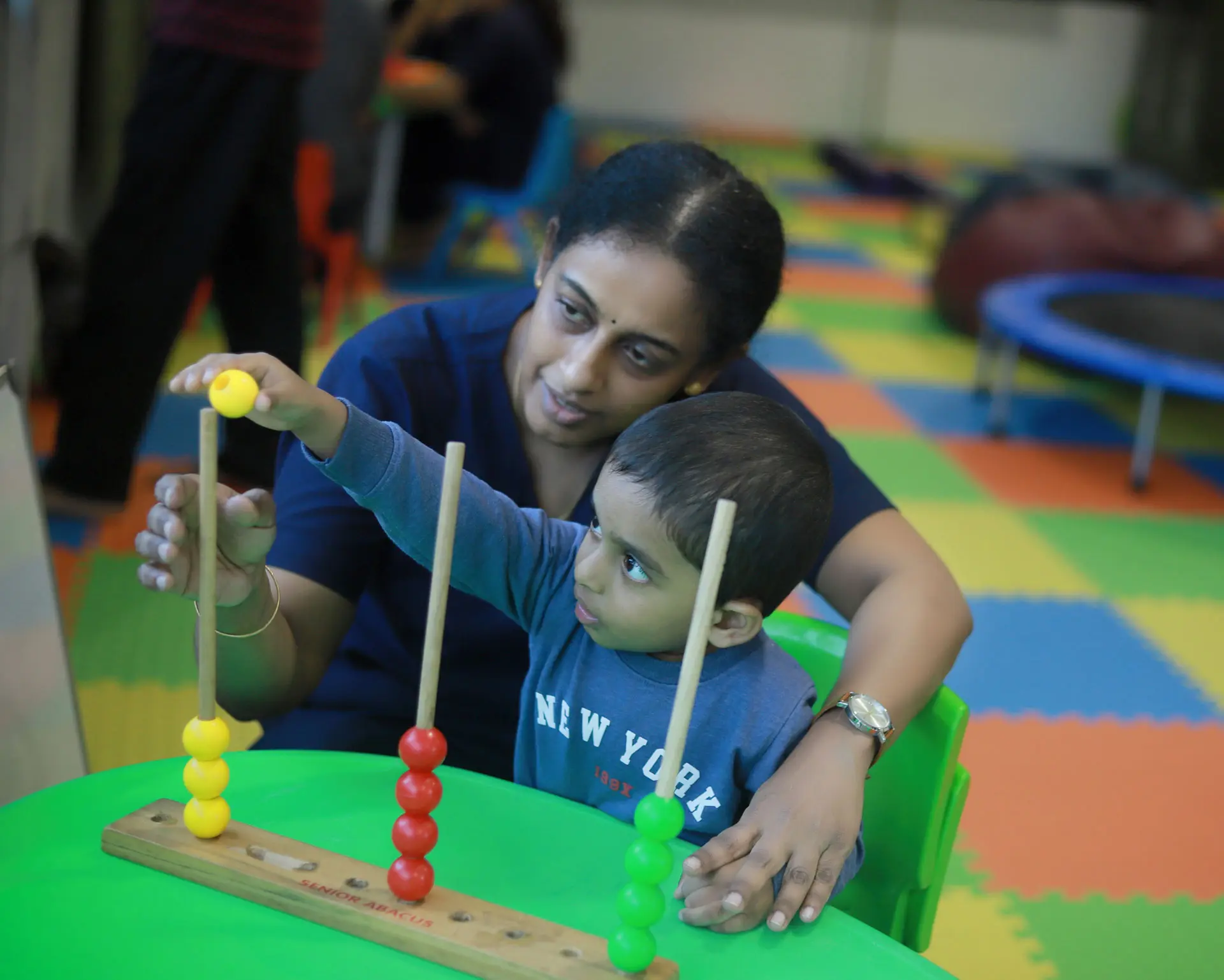Online Therapy

Prayatna Offers Best Online Therapy Programs
Our online assessment is similar to our regular assessment process involving standardized tests, interviews and observations. The duration of the assessment may vary depending on the child’s online engagement. If cooperation is a challenge during assessment, our therapist may request video recordings of your child’s regular activities. In certain instances, specific task recordings may be sought for deeper insights to identify the problem areas. After the assessment sessions, parents will be explained in detail about the diagnosis and the key intervention areas. Short term and long term goals will be set in discussion with parents. Once regular sessions begin, we will implement activities aligned with specific goals, and your child’s progress will be continually monitored.
Why Choose Prayatna for Your Child’s Online Therapy Needs?
Prayatna provides comprehensive online therapy that includes occupational therapy, speech therapy, ABA, special education, and behavior therapy, carefully designed to your child’s unique requirements. Our online therapy programs are scheduled for 45 minutes and the frequency and duration of sessions are planned based on the child’s strengths and specific needs. Regular therapy sessions via Google Meet are scheduled after taking into account parents’ availability and scheduling preferences.
Our online therapy programs are constantly reviewed and assessed for performance improvement. Changes and modifications are made wherever necessary until the child reaches the desired goal.


Parent Training and Guidance
Parents play a pivotal role in online therapy programs. Their total involvement and commitment make online programs successful. Our therapists train parents by practically demonstrating all therapy techniques and how to use different tools available at home during live sessions. Therapists may request parents to share video recordings of child’s therapy activities at home. By reviewing these recordings, therapists can adjust activities as necessary to align with targeted goals. This collaborative process empowers parents to effectively modify and implement activities within their home environment, fostering optimal progress and engagement in therapy.
Attend to Your Child’s Therapy Needs from the Comfort of Your Home
All cooperative members at home can take part in the training sessions. This helps perform the required activities throughout the day and achieve the desired goal. It’s been noticed that sibling and parent involvement is more in online therapy programs than in regular physical sessions which invariably helps in improving family relationships and influences the child’s emotional development positively.


How does it work?
In the absence of therapy rooms and therapy materials, during online sessions, our therapist suggests materials available at home.
For example
(1) Pillows, cushions and blankets are used to create an obstacle course for developing gross motor skills in children.
(2) Using small tweezers to pick small objects, and sorting beads or cotton balls help improve fine motor skills
(3) For a child with tactile sensitivity, introducing play using clay, finger painting, and sand play helps.
(4) In speech, modelling the targeted sounds in front of a mirror, to produce the respective sound helps.
Always remember to be patient as children need some time to adjust to new sensations. Once they show progress, reward them for every successful response no matter how small.
- Reliable Internet Connection: Ensure a stable internet connection with sufficient bandwidth is required to support video and audio streaming. This helps avoid therapy interruptions.
- Compatible Device: Prefer using a desktop computer or laptop with webcam, microphone and speakers. A tablet or a smartphone may be used in the absence of a desktop or laptop. Please make sure that the device is capable of running the necessary video conferencing software with clear audio and video.
- Updated Software: Make sure that your device’s operating system and any required software (such as video conferencing apps) are updated regularly. This helps avoid compatibility issues.
- Web Browser: Use a modern web browser such as Google Chrome, Mozilla Firefox or Safari for optimal compatibility with the chosen video conferencing platform.
- Quiet and Private Space: Choosing a quiet and private location for the therapy session helps avoid/minimize distractions and ensures confidentiality.
- Camera Positioning: Position the camera in a way to helps the therapist observe the child’s activities and also facilitates effective communication with the parent/caregiver.
- Good Lighting: Ensuring adequate lighting in the room enhances visibility and ensures that the therapist can see clearly.
- Headphones (Optional): Using headphones with a built-in microphone helps minimize background noise and improves audio quality, more specifically in shared or noisy environments.
By meeting these technical requirements, you can optimize your child’s online therapy experience and make the most of your sessions from the comfort of your home.
FAQ
Online therapy also known as Teletherapy is a form of therapy conducted remotely using telecommunications technology such as video conferencing. Different platforms such as Google Meet, Zoom, etc. are used for video conferencing. This form of therapy allows individuals to access professional therapy services from the comfort of their homes without geographical barriers.
Yes, online sessions do work. The caregiver who is attending the session with the child assumes the role of primary therapist to the child under the guidance and support of occupational therapist. This collaborative approach empowers caregivers to actively participate in their child’s therapy which invariably ensures continuity of care beyond the session. In online therapy, the sessions should be carried out in a quiet, distraction-free room with proper ventilation. It’s important to follow home programs diligently, and any videos or updates should be shared promptly with the therapist overseeing the program.
Yes, occupational therapy can be done at home. Home-based occupational therapy can be highly effective specially for individuals who may have difficulty accessing clinic-based therapy services. Therapists develop personalized treatment plans that target specific goals and activities to be carried out within the home environment. This approach allows for smoother integration of therapy techniques into daily routines and practice learned skills in familiar surroundings.
Yes, we offer special education services online. For special education sessions online, parents are required to sit with their child and attend the session. This helps the parents keep track of the child’s performance. Platforms preferred are zoom and google meet.
Yes. Applied Behaviour Analysis (ABA) therapy can be done virtually or remotely with supervision of a qualified behavior analyst. It should be remembered that the feasibility of online ABA therapy depends on the individual needs and skills of the child.
Certainly! Individual therapies such as Cognitive Behavioral Therapy (CBT) and Behavioral Therapy (BT) for adults can be effectively conducted online. However, for children, the suitability of CBT and BT depends on their specific needs, and these therapies typically require the supervision and guidance of a trained therapist to ensure effectiveness and safety.
Online speech therapy for individuals with autism is becoming increasingly common and accessible. Many speech therapists and clinics offer remote sessions via video conferencing platforms, allowing individuals to receive therapy from the comfort of their own homes. These online sessions can cover a wide range of speech and communication goals, tailored to the individual’s specific needs.
Yes. Numerous studies have shown that telepractice, including online speech therapy, can produce outcomes for a variety of speech and language disorders. Benefits of online speech therapy include:
- Convenience
- Engagement
- Individualized Attention
- Parent Involvement
- Access to Specialists
However, it’s important to note that the effectiveness of online speech therapy for children, including those with autism, can vary depending on factors such as the child’s individual needs, the therapist’s expertise, and the level of parental involvement.
Online speech therapy can address a wide range of speech and language delays and disorders, including Articulation Disorders, Phonological Disorders, communication disorders, Fluency Disorders, Voice Disorders, and Pragmatic Language Disorders etc.
A typical online speech therapy session follows a structured format that is flexible too. It is tailored to the individual needs and goals of the client. The process of online sessions are almost similar to that of direct sessions where the clinician as well as the parent interacts with the child. This interactive process ensures that the therapy is personalized and effective in addressing the specific challenges faced by the child.
Online speech therapy offers several benefits for children like:
Convenience: Online therapy eliminates the need for travel to and from a clinic, saving time and reducing stress for both children and their caregivers.
Accessibility: Online therapy expands access to speech therapy services for children who may live in remote areas or have limited access to in-person therapy due to transportation.
Flexibility: Online therapy sessions can be scheduled at times that are convenient for the child and their family.
Engagement: Many children are comfortable using technology and may find online therapy sessions engaging and interactive. Therapists can incorporate multimedia materials, interactive games, and virtual rewards to keep children motivated and focused during sessions.
Specialised equipment isn’t always necessary for online speech therapy. But a few basic items can enhance the effectiveness of the sessions like a computer/laptop, good internet connection and interactive materials/toys.
The frequency of online speech therapy sessions for a child depends on several factors, including the child’s specific needs, the severity of their speech or language disorder, their age, and their response to therapy. Generally, the frequency of sessions is determined by the therapist in collaboration with the child’s caregivers and may vary over time based on progress and changing needs.
The time it takes for a child to see results from online speech therapy can vary widely depending on the severity of the child’s speech or language disorder, their age, their responsiveness to therapy, the frequency and intensity of therapy sessions, the consistency of practice between sessions and most importantly how well the parent/caregiver home trains the child on the prescribed goals.
Related Blogs

How to Implement Effective ABA Therapy Strategies at Home
Written By Hudha Haris, MA Psychology Psychologist Clinically Reviewed By Divya Krishna, MSc(Psy), MPhil, QBA, IBA Rehabilitation Psychologist and ABA Therapist Whether you’re a parent,

Occupational Therapy Activities for Kids
Written by Anakha Pisharody, MOT Paediatrics, Occupational Therapist Kids are curious. They are little explorers, exploring everything around. They love doing things and keep looking

Online Speech Therapy: Speech Therapy At Home Made Easy
Written By AKSHAYA KRISHNAN MSc SPEECH LANGUAGE PATHOLOGY SPEECH LANGUAGE PATHOLOGIST Are you unable to attend speech therapy because you don’t have access to speech
